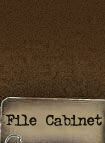
Case Title:
Deadly Ending of "HiWi's"
Uprising
Subject: Russian POW's,
put to work at German Anti
Aircraft gun positions near the
Philips factories in Eindhoven
tried to escape one night late
in the war. Their captors
reacted with machine gun fire
and put a deadly end to the
uprising.
Date: Approximately 1944
Location: Eindhoven,
Holland
Introduction: As a young
boy, Battle Detective Tom asked
his Mother, who was seven years
old in 1944, if she had ever
seen 'dead people' during the
war. A common question for boys
of Tom's age at that time, we
learned later. His mother,
Greetje Matla, told the story of
Iwan. Iwan was a Russian soldier
who was kept prisoner by the
Germans. Greetje walked by where
Iwan was held, on her way to
school on Barrier Weg in
Eindhoven, Holland. Although she
could not actually speak to him,
they were able to communicate
somehow. She even shared her
school sandwiches with the
Russian. One morning she walked
by Iwan on her way to school,
only to find him lying on the
ground. Dead.
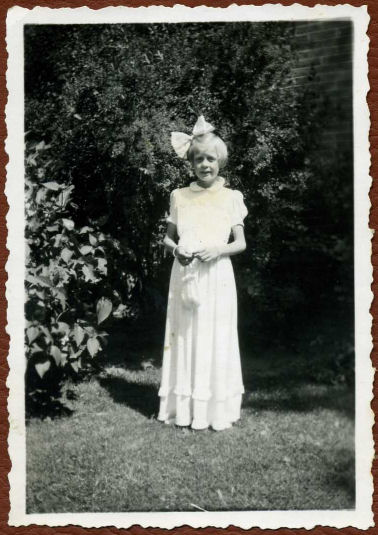
A recently
discovered photograph of Greetje
Matla at the age of 7
on the day of her
First Holy Communion in 1944
Unfortunately, Greetje died far
too early in 1990. Therefore,
Tom had never been able to ask
his Mother for more details
about this story. However,
recent battle detective work
sheds more light on Iwan's
story. And his death.
The Story: Battle
Detective.com talked to
Jan and Jenny Van Hout from
Eindhoven. Like Tom, they are
members of the
Association of Dutch Airborne
Friends. Jenny was two years
older than Greetje and also
lived in Eindhoven
during World War Two. Jenny
lived on Bosch Dijk. She and
Greetje
probably went to the same
elementary school because Greetje's school was
commandeered by the German
occupiers of Holland and used to
billet Wehrmacht soldiers in it.
Jenny told about the Russian
soldiers who were put to work at
a German Anti Aircraft, or
"Flak", position on a vacant lot
near Marconi Laan. She also
spoke of Russians that she and
other school children talked to.
Jenny remembers throwing her
left over sandwiches across the
wire perimeter fence around the
gun position.
She remembered seeing 'green
cupola's', obviously referring
to the grassy man-created mounts
shown in this period photograph
of the gun location on Marconi
Laan:
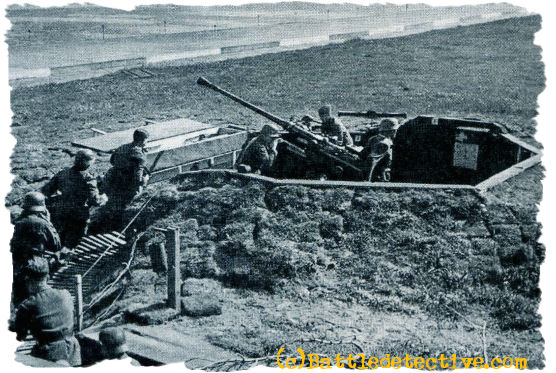
Photograph from
the two-volume book by author A.
Hermens about WWII air raids on
Eindhoven
Jenny's home was also close to
the gun site and one night she
remembered hearing the sound of
automatic machinegun fire. What
struck her at the time was that
the shooting was not forewarned
by the usual air raid sirens.
Therefore, Jenny was not
particularly worried. During our
interview, she even stated that
she sort of enjoyed listening to
the drumming sound of the
automatic fire. How upset was
she the next day when she
learned of an uprising by the
Russians. Local people spoke of
an escape attempt by the
Russians who had even tried to
kill their captors. The escape
had failed and some of the
prisoners had been killed. Jenny
never saw any of the Russians
who where shot during the
eventful night.
We showed Jenny a detailed and
enlarged aerial photograph of
the rectangular shaped lot
enclosed by Marconi Laan, Bosch
Dijk, Lijmbeek Straat and the
rail road between Eindhoven and Boxtel. The
photograph was taken on the 26th
of December 1944. On it, she
pointed the various gun
emplacements, crew quarters,
shacks for the Russian
prisoners and other details.
This is the photograph:
(Click on the
image to enlarge)

On this aerial photograph, taken
over a year earlier on
the 21st of October 1943, the
Philips factories are visible in
the lower left corner. The rail
road runs in front of it.
(Click on the
image to enlarge)

The Philips factories were of
strategic value to the Germans
and therefore they made a prized target
for the Allied Air Forces.
This is a picture of the
factories today. The rail road
is now built on a raised ramp.
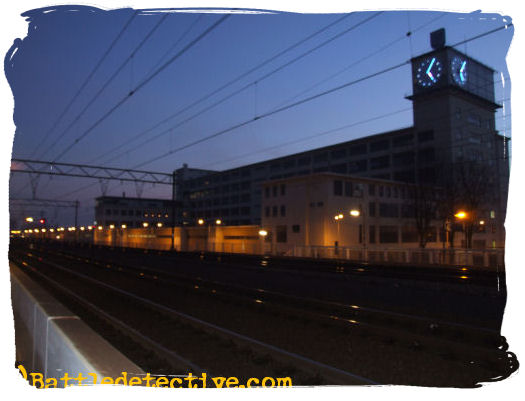
The vacant lot in front of the
Philips factories in Eindhoven
(in the suburb of Strijp) where the
Flak gun positions where, has
been developed into a
residential neighborhood, making
a Now & Then-comparison
difficult to produce.
(Click on the
images to enlarge)
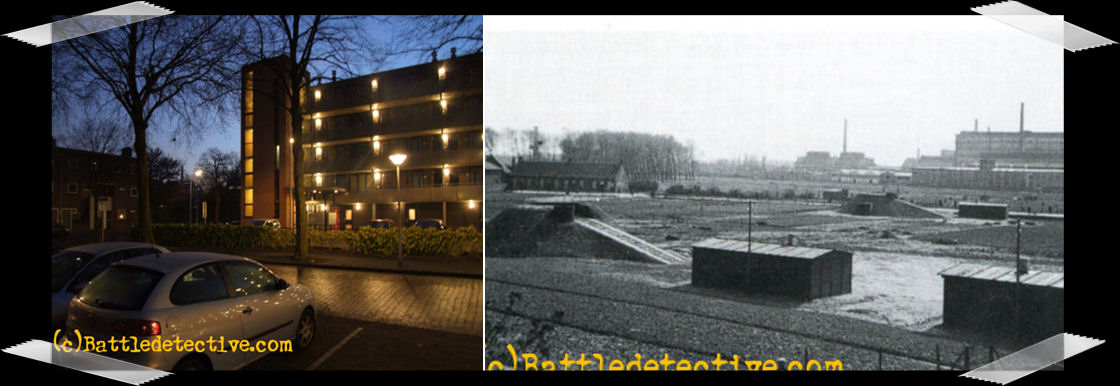 |
Because the
vacant lot in front of the
Philips factories is now a
residential area, it is
difficult to make a Now &
Then-comparison. The
smokestack in the middle of
both photographs serves as a
reference point.
|
 |
Our photographer stood on
the rail road ramp and took
his picture in the same
direction as the
photographer in the "Then-"
picture. This was taken from
one of the factory rooftops
in the winter of 1941. The
flak guns had not yet been
positioned in the vacant lot
at that time. |
.jpg) |
In April 2011 we were kindly
allowed to take a photograph
from the same window in the
Philips Factory "Clock
Building" as the one from
which the 1941 photo was
taken.
|
The Russians: Most likely,
the Russian soldiers were so-called
"HiWi's", an acronym for
Hilfswillige (Auxiliary
Volunteer).
After the invasion of the USSR
thousands of captured Soviet
soldiers volunteered to fight
against the Soviet regime.
Initially the Germans declined their
employment, but because of the many
casualties in the Eastern Front and
in North-Africa, accepted them in
non-combat roles. They were given
engineer and supply tasks. In
Eindhoven these HiWi's were
instructed to work in various Flak
positions throughout the city and in
the Welschap Luftwaffe Air Base.
This photograph was taken on the
18th of September 1944. It shows
five Russian soldiers, taken
prisoner by paratroopers of the
101st at a Flak gun location in
Eindhoven. The man with the peaked
cap is an Eindhoven Police officer.
The paratrooper is of "HQ"-Co./506th
Parachute Infantry Regiment, trying
to determine whose side these men
were on. A small portion of the
black helmet of a PAN-resistance
member can be seen in the far left
edge.

We have not been able to
substantiate the story about the
escape attempt in any documentation
so far. We are however pleased that
our investigation has confirmed a
remarkable story that was told a
long time ago. |


